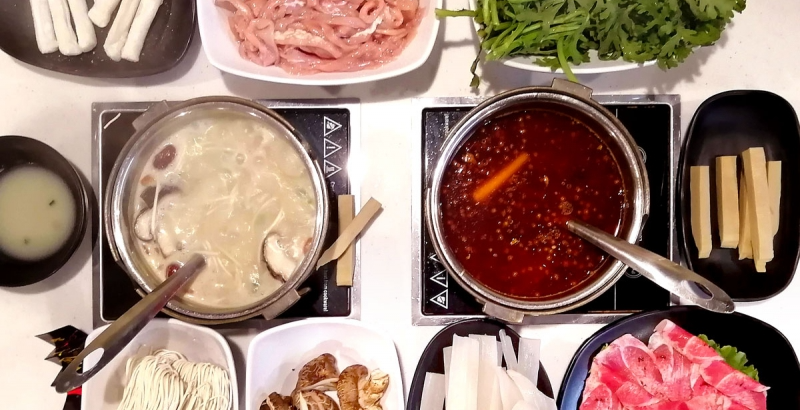There was a trend that started in New York City in the 1980s. If one was to open a new restaurant or club, the worst thing to do is to advertise or promote the new venture. If you really wanted your joint to succeed, you better hide your address, have an unlisted phone number, and never put a sign up at your entrance. Thankfully, websites and social media did not exist then because what you really want is the best advertising that you can get: sincere word-of-mouth from happy customers. If you do it right, you’ll be turning away customers at the door or have months-long waiting lists for reservations. Of course, a few celebrity regulars didn’t hurt either, but secrecy creates exclusivity and exclusivity creates desire.

Photo by Paul Young.
So when my partner and I walked by this new restaurant next to Fresh International Market one evening, we couldn’t help noticing that this place was hopping with happy customers. We glanced up and stared at the awning: there was no sign. We’re curious people, so we had to go in to check this place out. Fortunately, it was still early, and there were still two tables open, so we asked for one of them.

Photo by Paul Young.
Spoiler alert: this place was so good we had to go back again a second time within a week. Truth be told, we made some mistakes the first time, so we wanted to go back and do it right the next time. Practice makes perfect, and there’s no shame in admitting that you’re a newbie. So instead of a restaurant review, I think I’ll write an instruction manual instead.

Photo by Paul Young.
When we entered for the first time, our host asked if we wanted a large table or a small table. There were only two of us, so we opted for the small table. This was our first mistake. Each small table had four seats with four burners, so that each guest could have their own individual hot pot. My partner liked this because she thinks I have weird tastes when it comes to food. True, but hot pots are meant for sharing — and this is one restaurant where sharing is essential. Each table also had its own QR code, and the host told us that the menu is online. We were not surprised, but we’re old school, so we asked if they also had paper menus. The answer was thankfully “Yes,” and fortunately, the menu was also in English.

Photo by Paul Young.
The menu came with a pen, so we assumed that the checkboxes were for us to mark, just like those paper menus at Chicago’s dim sum palaces in Chinatown. However, this menu was more than just a menu, it was also a well-designed newbie instruction sheet clearly marked with Step One and Step Two.

Photo by Paul Young.
When I flipped the menu over, I entered foodie heaven. Just like Spicy Tang, the choices were overwhelming but super exotic. My favorites were all there: beef tongue, pork belly, cuttlefish, shiitake mushrooms, and a long list of veggies, but what caught my eye were the exotic hard-to-find ingredients: chicken gizzards, duck blood, goose intestines, tofu skin. There was stuff I’ve never heard of: beef aorta (artery from the heart) and beef louver (the hairy stomach from one of the cow’s four stomachs).
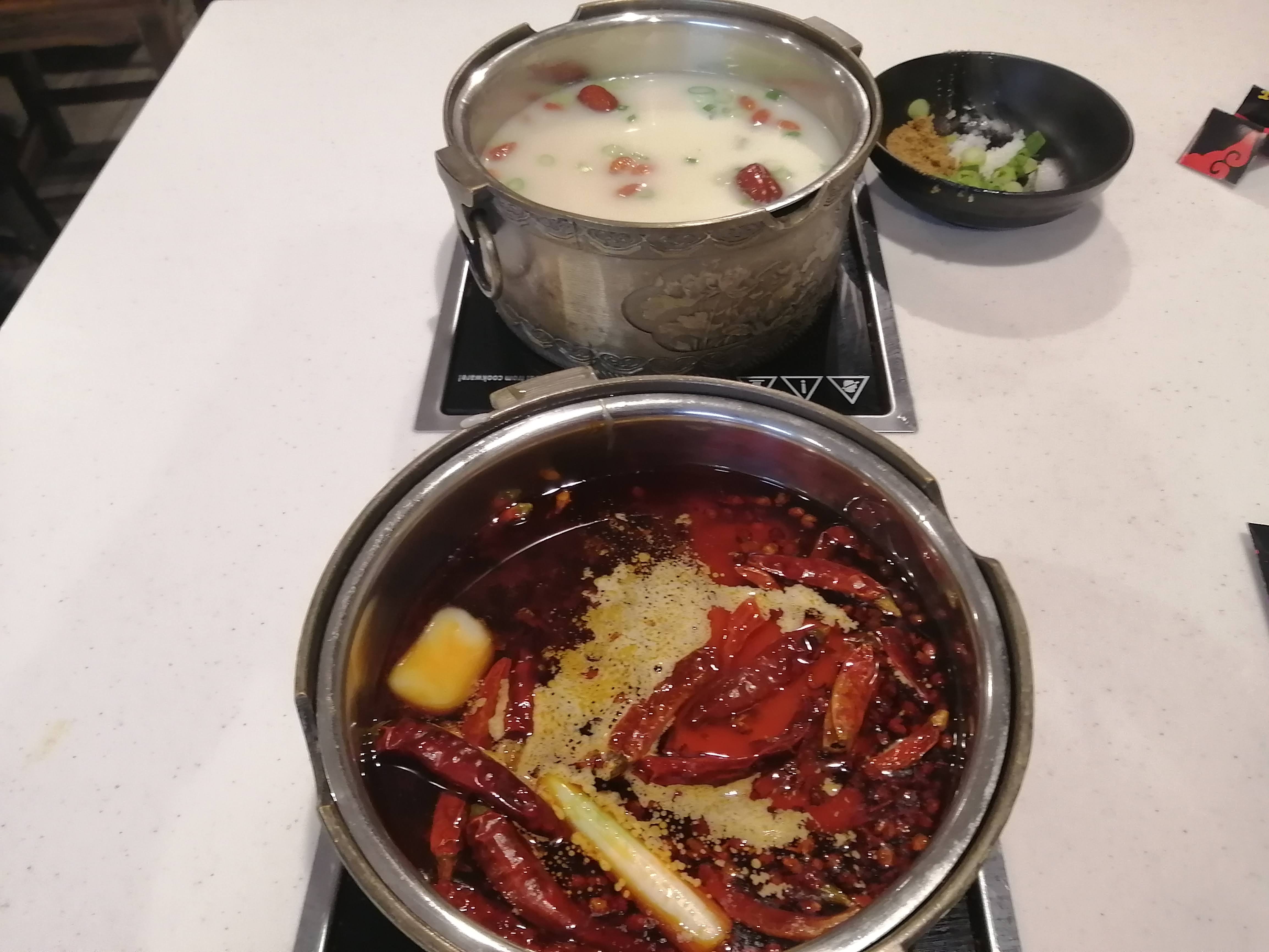
Photo by Paul Young.
Following the instructions on the menu, we ordered two single pots ($10 each) with original broth and spicy beef tallow broth. There were three spice levels, and I went easy on myself and checked the one pepper option. The pots were delivered in no time, and the waiter instructed us on how to control the temperature on our stoves. He also warned us that the pots will get very hot and to be careful not to touch the metal. But the stove itself? Not even warm because these were induction burners which somehow miraculously heated the pot with magnets.

Photo by Paul Young.
Our habit is to over-order — not because we had big appetites, but because we just can’t help it; life is short, and if we don’t indulge now, there might not be a tomorrow. We usually have to fight over what to order because our tastes are different, but it was not an issue here. We had separate pots, so there was no chance I could contaminate her broth with goose intestines.
What was the first item I checked on the menu? Goose intestines. Then, I add beef tongue, gizzards, and sweet potato noodles. She checked soup dumplings, shiitake mushrooms, frozen tofu, and regular noodles. We both agreed that we needed some greens, so we chose tonghao (chrysanthemum greens), a mildly bitter but tender green leafy vegetable. When we submitted our order, we immediately regretted losing the only copy of the menu.
The drink options didn’t appeal to me. Since the restaurant doesn’t have a liquor license, I asked for permission to go to the grocery store next door to grab something. With permission granted, I spotted a bottle of soju, Korean rice spirits, and when the waiter saw what I had found, he brought me an extra glass with ice without asking. It was nice of him, and BYOB is actually encouraged!
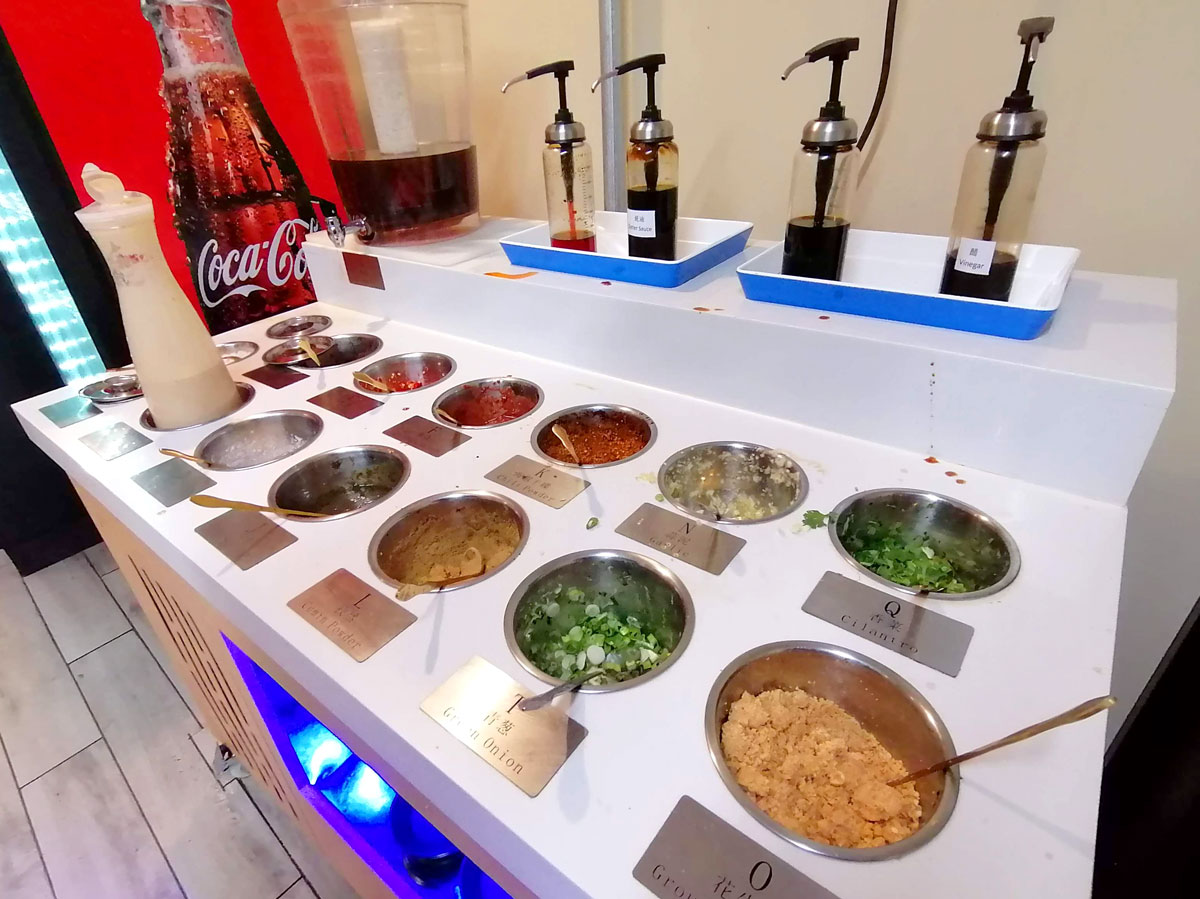
Photo by Paul Young.
While our broth was boiling, we went to the condiments bar ($2 per person extra) and built our own custom bowls of extras. At taco joints, one tends to judge the quality of the restaurant by the variety and quality of the toppings available. At hot pot joints, I do the same, and this restaurant did not disappoint.
Of course, they had the standard fare covered: soy, vinegar, sesame oil, green onions, garlic, cilantro — all the expected items were there. But then I spotted the special extras: Thai chilis, chili powder, cumin powder, satay sauce, peanut sauce, hot oil, and more. Fermented bean curd? Leek flower sauce? Wow, more new stuff to try! Then I spotted the MSG. Wait, isn’t that a chemical additive that’s bad for you? Don’t Chinese restaurants proudly proclaim “no MSG” on their menus? This American Life had an episode that got to the root of this wild xenophobic conspiracy theory. The scientific evidence showed that not only is MSG harmless, it also makes food taste better. So, sure, I added some MSG to my soup.

Photo by Paul Young.
Instead of getting two bowls of dipping sauces, we decided to share one bowl of our extra special custom-mixed sauce made with soy sauce, green onions, garlic, Thai chili peppers, sesame oil, satay sauce, and a little leek flower sauce. That should add a little zing to every bite. Being seasoned home cooks, we like a lot of bling in our broth, so we got an extra bowl of goodies to enhance the already tasty broth: more garlic, more green onions, some fermented bean curd, and a little MSG. We dumped this bowl right into our boiling broth which added complexity and extra zest to our soups.
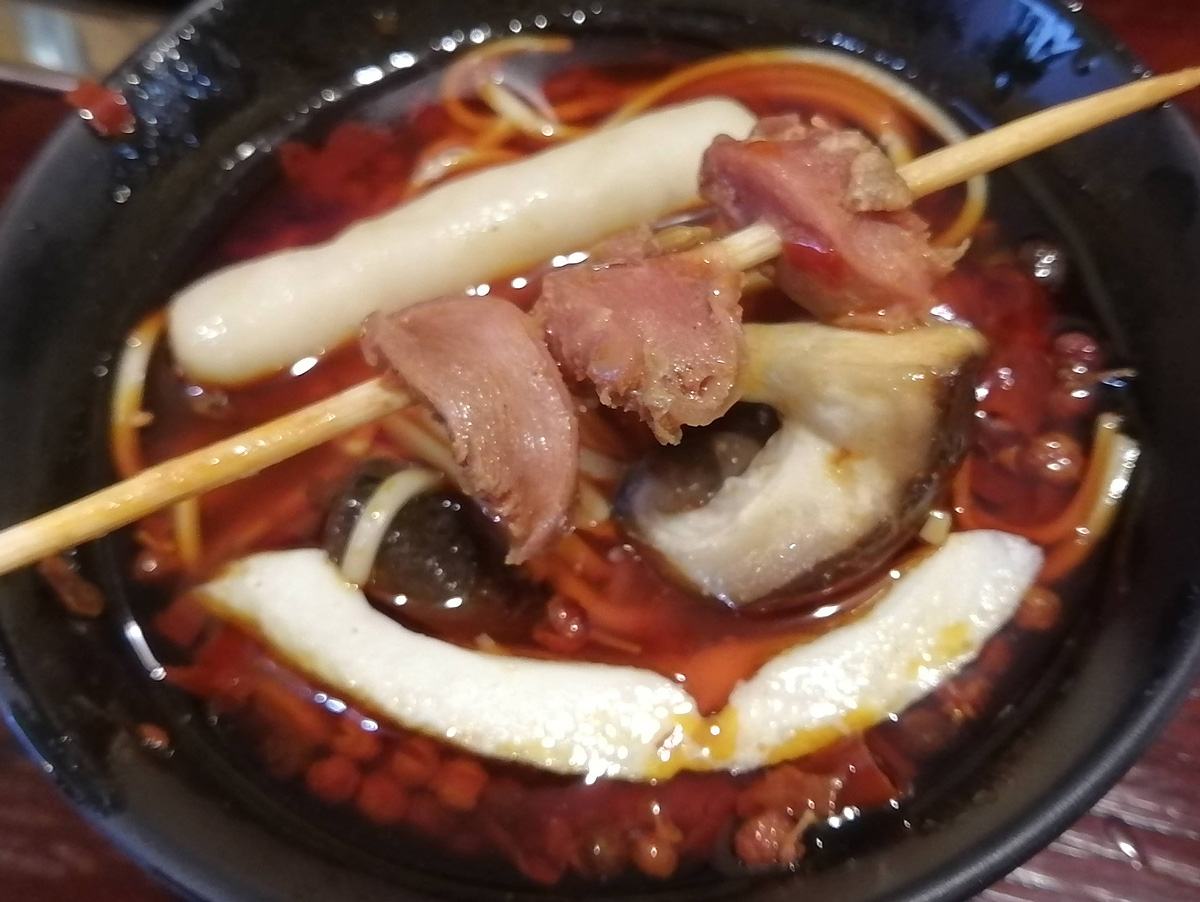
Photo by Paul Young.
We knew some ingredients needed longer cooking times to absorb the broth, so the mushrooms and tofu went in first. The sweet potato noodles looked thick, so that went in next. We threw in the thinly sliced beef tongue and the greens last. We turned down the heat, grabbed our bowls and started ladling a little broth, some noodles, and a few morsels of tasty bites. I sampled her original-flavor broth which looked somewhat milky but tasted wonderfully fragrant and rich. I tasted my beef tallow broth which was strong, potent, rich, and spicy.
Now the fun really began. How about dumplings, followed by mushrooms? Another sip of broth prepared my mouth for the next bite. It was damn spicy but good. I ordered the “mild” one-pepper version, but this broth was much spicier than most other three-pepper versions. Hell, I’m a man, and I’m Asian; I can handle heat. A bite of gizzards without broth and some chewing tampered the heat. The gizzards sure had a nice spicy afterbite. I cook with Sichuan peppercorns at home, slather extra jerk sauce on chicken, and I’m addicted to fermented Mexican habanero sauce — this was no big deal. I picked out a few noodles to try to balance the heat in my mouth. No such luck, the noodles had already soaked in the spicy broth. I drank some soju (oops, a mistake!), and the liquid spread the heat all over my mouth which was now on fire.
My nose began to drip, and my eyes started to water. “Ask for some rice,” my partner said. Nah, real men don’t eat rice, so I soldiered on blowing my nose and wiping away my tears between bites until the table was full of used napkins. After a few more bites, I had to stop. For the first time in my life, I had reached my limit. This is definitely without question the spiciest meal I’ve ever tried to eat. How do other people do it? I glanced at the next table, and I spied them ladling a little of the hot spicy broth into the not-so-spicy broth in the next compartment of their big pot — and then eating out of the milder side.
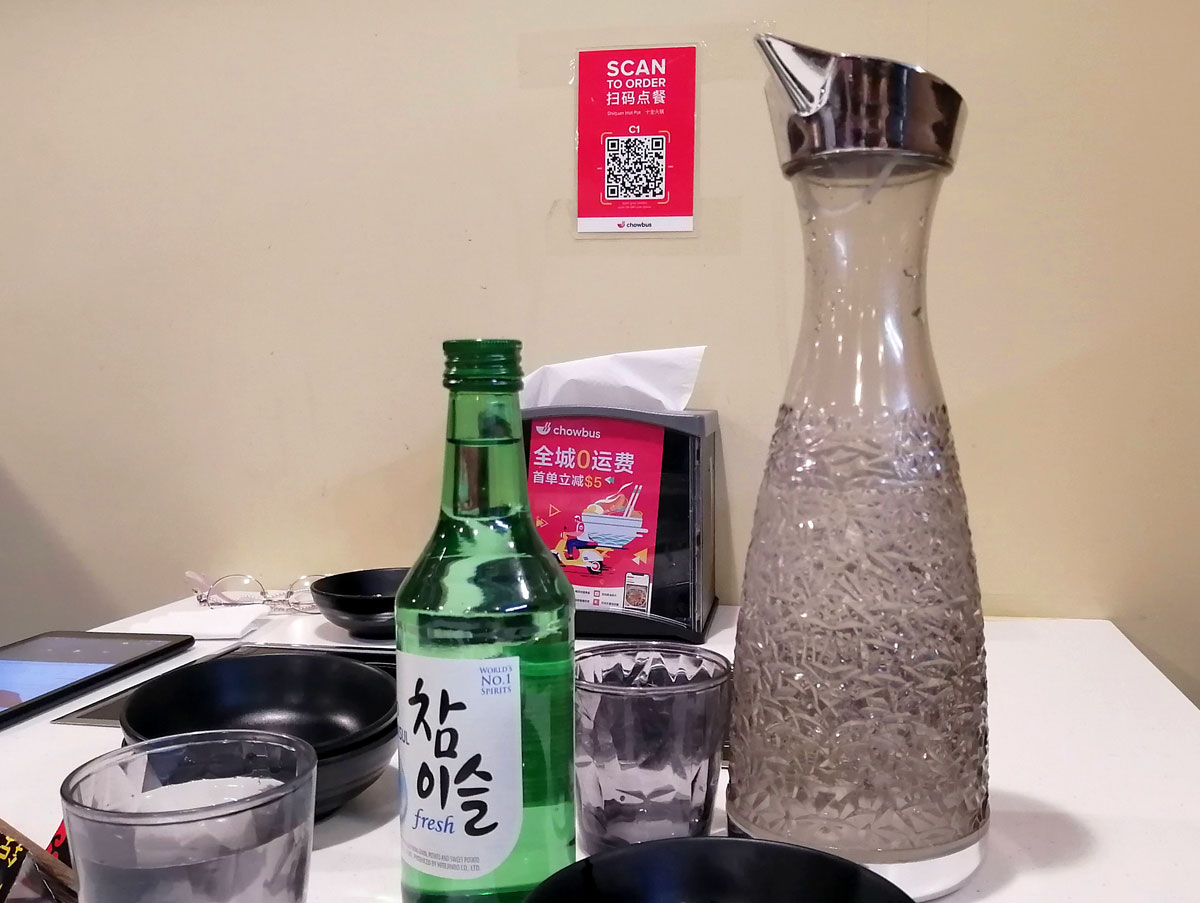
Photo by Paul Young.
Okay, that makes so much more sense. I need a re-do; that’s not against the rules, is it? So the next week, we ventured out again, this time a little bit more experienced, a little more confident, and a little more arrogant. This time, we got our soju first and even brought our Android tablet. Feeling like more seasoned diners, we confidently entered the restaurant and asked for a big table this time.
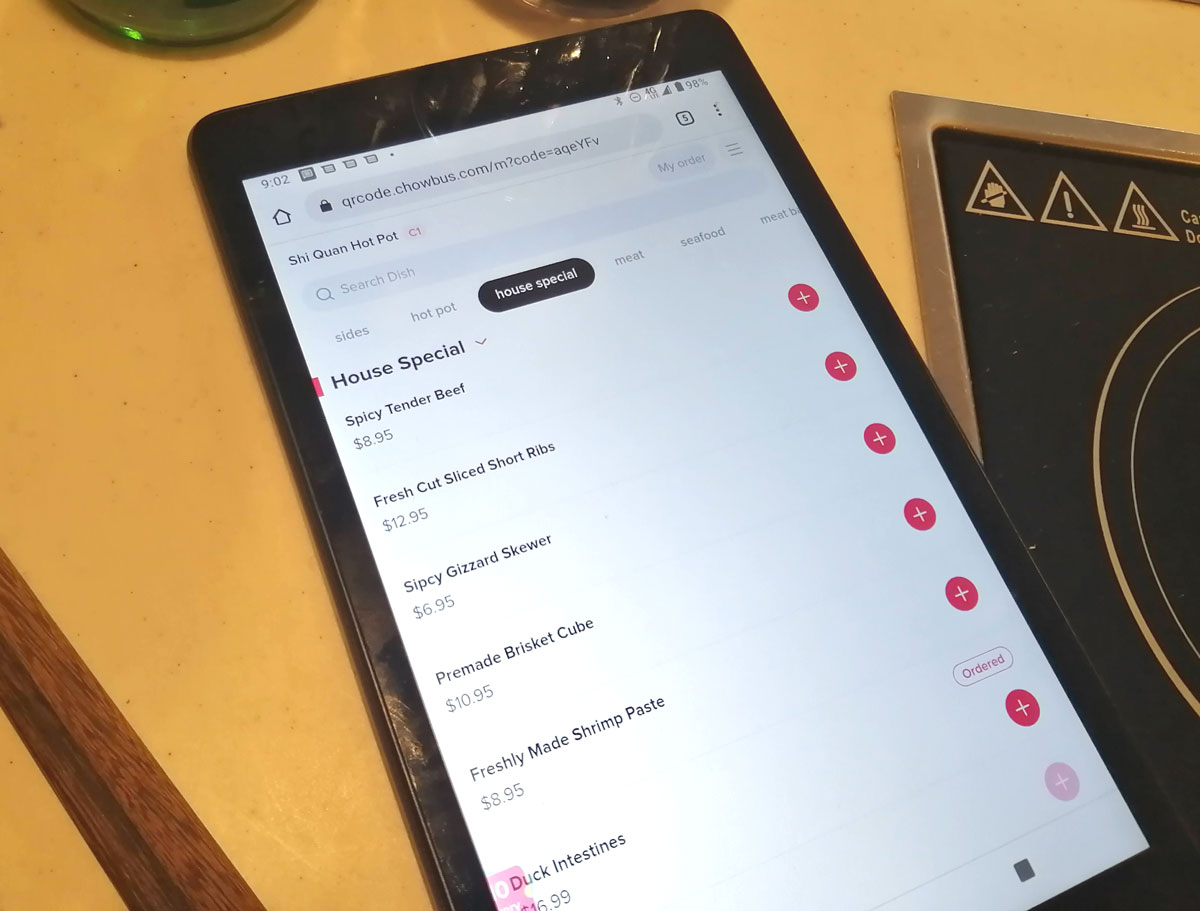
Photo by Paul Young.
Knowing only newbies ask for a paper menu, we immediately whipped out our tablet, scanned the QR code, and started tapping away. We were surprised to be directed to the Chowbus site even though we were eat-in customers. Our table number was in the app which implied that each table had their own QR code. I didn’t know that Chowbus offered restaurants this kind of customization in their app, but then I knew nothing about Chowbus except that every local Asian restaurant in town is on it. According to their website, Champaign is one of only 23 cities currently served in the U.S..
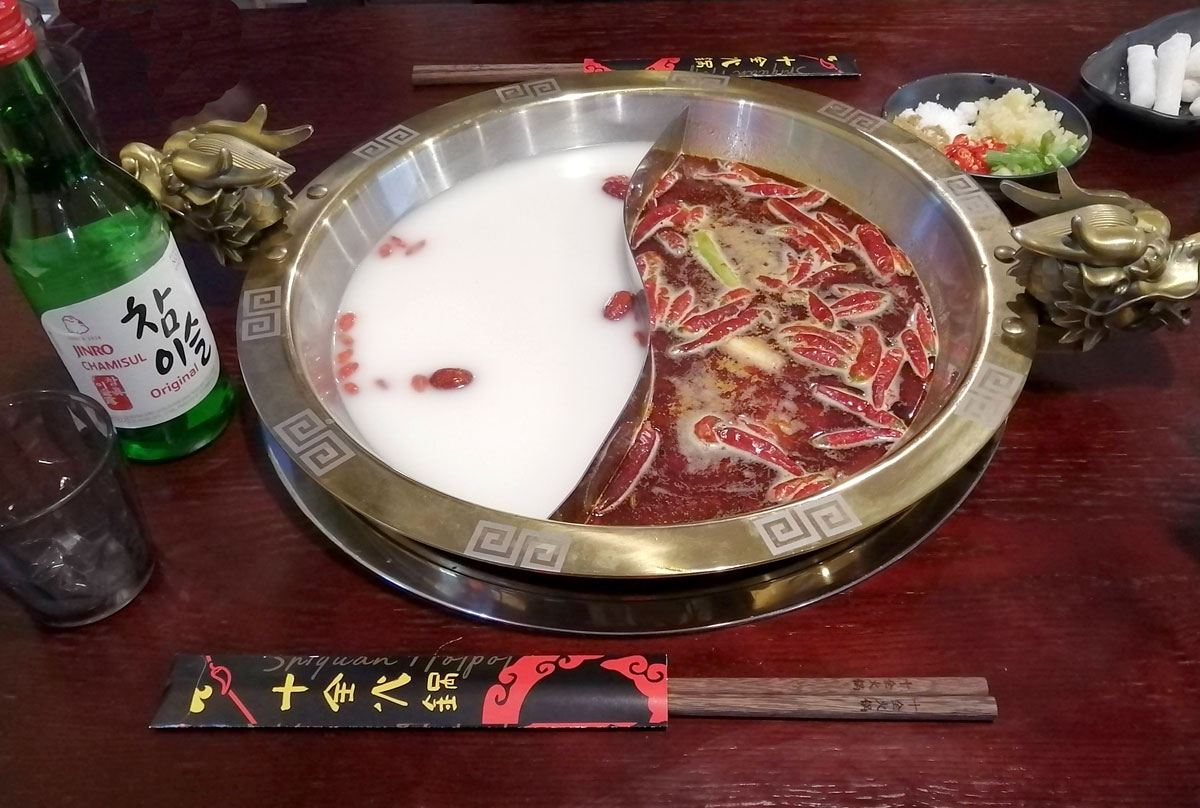
Photo by Paul Young.
We’re smarter now, so we ordered the half-and-half split pot knowing that we’re going to be doing some broth mixing this time.

Photo by Paul Young.
I didn’t get to try the beef aorta last time, so that was the first item I ordered. The beef aorta did not have not much flavor but had a nice chewy texture not that different from beef tendon.
She was in the mood for some seafood, so she ordered baby cuttlefish which was wonderfully tender like undercooked squid. We threw in a bunch of our old favorites and waited in anticipation of another exciting meal. When we were done with our order, we simply tapped the send button and got an acknowledgement note with an invitation to add to our order at any time.
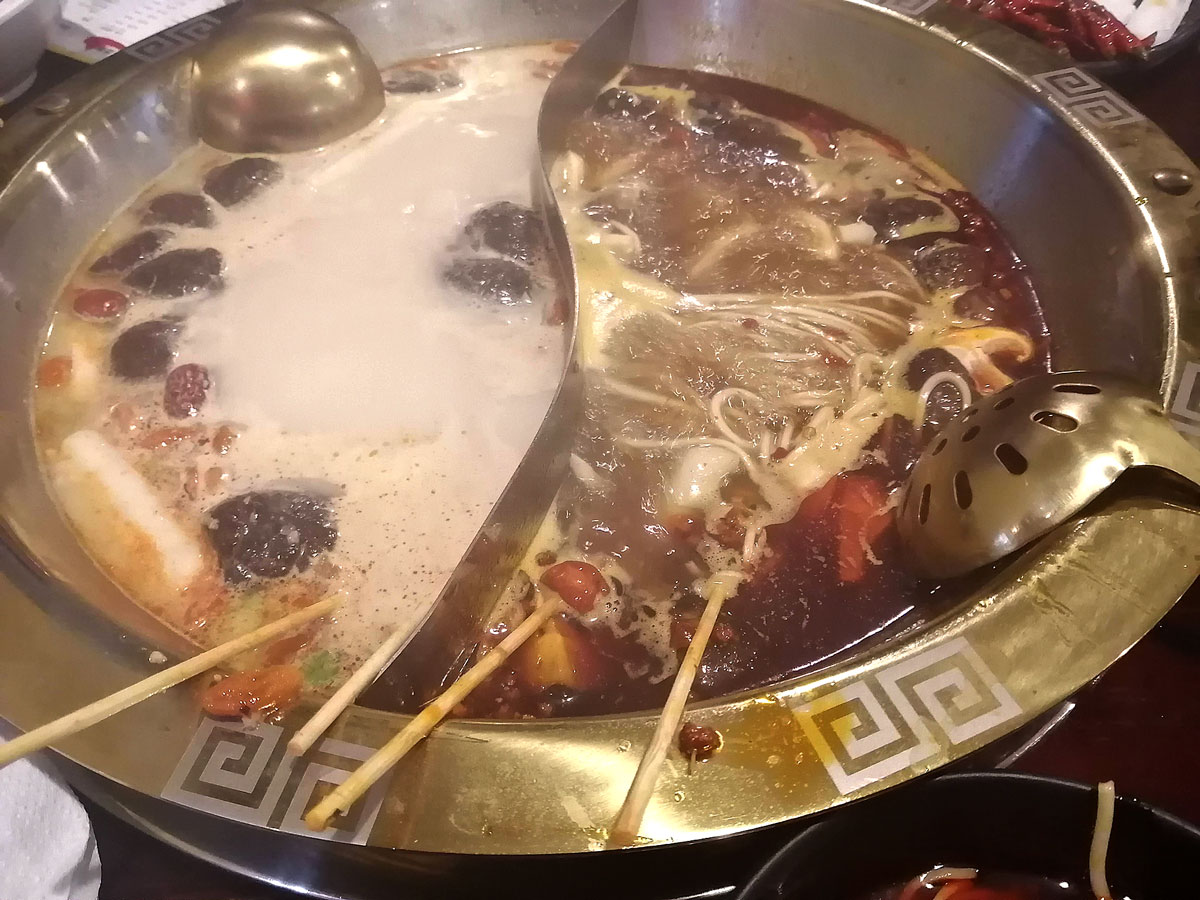
Photo by Paul Young.
As soon as the broth arrived, I spooned out most of the red hot peppers and set them aside. I also tried to get out some of the Sichuan peppercorns, but they were too small and too challenging to scoop out. When the split pot was steaming hot and boiling, we started ladling some hot spicy broth into the neighboring compartment carefully, one ladle at a time, always tasting in between each ladle because there’s no “undo” button when it comes to food. When we reached just the right amount of spiciness, we stopped.
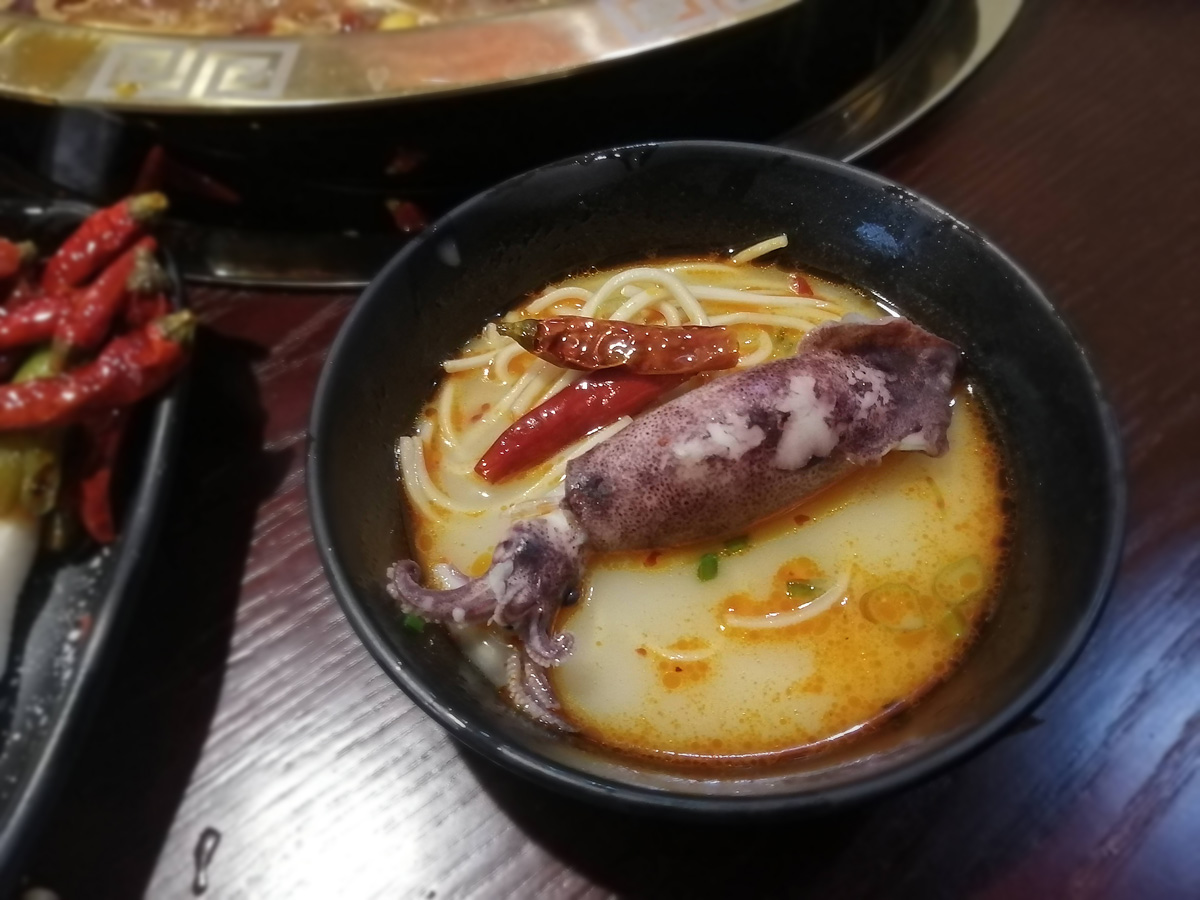
Photo by Paul Young.
I still cooked a few of my ingredients in the spicy broth to soak in some potent flavors, but this time I washed each morsel in the mild broth before transferring it to my mouth. That’s exactly how I like it: hot, spicy, flavorful, but no need for tears. There you go, the secret way to do Sichuan-style hot pot the right way, and now you can go and try this yourself.

Photo by Paul Young.
Where is it located? That missing sign? We finally found it. It was inside Fresh International Market, the grocery store next door. I guess they know their audience; if you shop there, then you’ll want to eat here. When I asked the manager if they’re associated with the grocery store, he said “No,” — they just rent the space from them. When I asked how long they’ve been open, he replied, “Three months.” I asked why they don’t do more promotion or build a website? He looked around at the full dining room, and the answer was obvious.
Our two meals at Shiquan Hot Pot cost $157 total with tax and tip. That’s about $80 per meal for two people. Yes, it wasn’t cheap, but the experience was worth it. Can you have the same experience for less money? Yes: just skip the expensive exotic ingredients like goose intestines ($18) or cuttlefish ($8). One single pot and one half-and-half split pot costs the same ($10), so go for the split version and share. Most veggies are between $3 to $4, and some meats are under $6 (like chicken breast and pork belly), so be selective.
The bottom line: I love trying new things and discovering new flavors — and Shiquan Hot Pot scratched that itch on multiple levels. I now have wonderful memories and some new favorites to write home about: goose intestines (so delicate and ever so slightly tender with a hint of fowl), beef tongue (melt-in-your-mouth beefy flavors much better than prime rib), chicken gizzards (always loved the extreme texture, but this version was nicely marinated in some secret sauce), sweet potato noodles (their extra-wide version had a wonderfully firm chewy texture but still soaked up the broth nicely), and soup dumplings which technically are just rolled up noodles (a pleasant surprise and another first for me).
Shiquan Hot Pot serves delicious food, fresh and interesting high quality ingredients, and with responsive service. Takeout and delivery are available via Chowbus.
Hot pot places in our town come and go. I remember this same space having once housed Cao’s Hot Pot which I never tried. Even Red Cape Hot Pot on Green Street and its very popular predecessor Hot Pot Lab didn’t survive. I think Shiquan Hot Pot will do just fine as more word-of-mouth good review spreads — not that they need more business.
Shiquan Hot Pot
505 S Neil St
Champaign
T-Th 5 to 9:30 p.m.
F 4 to 10 p.m.
Sa+Su noon to 10:30 p.m.
When he is not watching one film a day, Paul Young likes to travel the world seeking good things to eat. So far, he has eaten his way through 25 countries, and he loves to share his culinary discoveries with cooking classes.
Editor’s Note: A previous version of this article misspelled the name of the restaurant. The article has been updated to reflect the correct spelling. We regret this error.








